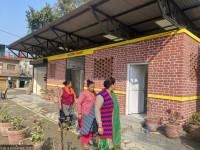Money
Nepal Rastra Bank mulls narrowing interest spread
The Nepal Rastra Bank (NRB), the central monetary authority, has signalled that it may be compelled to narrow interest spread, the difference between lending and deposit rates, from existing 5 percent, if banks and financial institutions fail to show efficiency and continue extending lower returns to depositors while collecting higher interest from borrowers.
The Nepal Rastra Bank (NRB), the central monetary authority, has signalled that it may be compelled to narrow interest spread, the difference between lending and deposit rates, from existing 5 percent, if banks and financial institutions fail to show efficiency and continue extending lower returns to depositors while collecting higher interest from borrowers.
The NRB had fixed the interest spread few years ago after depositors complained of getting very little return on money parked at banks and financial institutions, while borrowers complained about credit becoming way too expensive. With the introduction of the interest spread, banks that offer deposit rate of, say, 4 percent cannot charge interest of more than 9 percent on loans.
The spread rate of 5 percent was, in fact, supposed to work as a ceiling. This means competition should have lowered the interest spread of banks and financial institutions to below 5 percent. But that does not seem to be happening here, because interest spread of commercial banks, on average, has always stood at over 5 percent. Nepal’s banking sector is seeing such as wide interest spread at a time when “interest spread in India has dropped to 3 percent”, Nara Bahadur Thapa, executive director of the Research Department at the NRB, told an interaction organised by the NRB on Monday.
“This indicates banks and financial institutions are not operating efficiently here,” he told the Post on the sidelines of the interaction programme. The wider interest spread has also enabled banks and financial institutions to book profit of double digits every passing year. Net profit of commercial banks, for instance, jumped 32.1 percent to Rs31.40 billion in the third quarter of this fiscal year. This surge in profit, ironically, does not resonate with economic growth of the country, which stood at around 4 percent in the last one decade.
Banks and financial institutions in Nepal are often charged of maximising their profits at the expense of depositors and borrowers. They try to offer as little to borrowers and obtain as much as possible from borrowers.
“If this continues, the country may not attain higher economic growth rates because credit will always remain expensive, while depositors will not get what they deserve, which will encourage them to look for other investment avenues, reducing deposit stock,” said Thapa. It would be better if banks can introduce floating and fixed interest rates on credit, said Saurav Jyoti, executive committee member of the Federation of Nepalese Chambers of Commerce and Industry, the largest private sector umbrella organisation.
“We need fixed interest on loans extended for development of hydropower projects, as interest volatility, especially sudden jump, can raise project cost significantly,” Jyoti told the interaction organised to gather suggestions for formulation of upcoming Monetary Policy.
Others attending the interaction suggested that continuity be given to relaxation on calculation of credit to core-capital-cum-deposit ratio for at least a year, personal home loan ceiling be extended to Rs20 million from existing Rs10 million, and the productive sector be redefined so that many job creating sectors could be incorporated




 18.12°C Kathmandu
18.12°C Kathmandu













